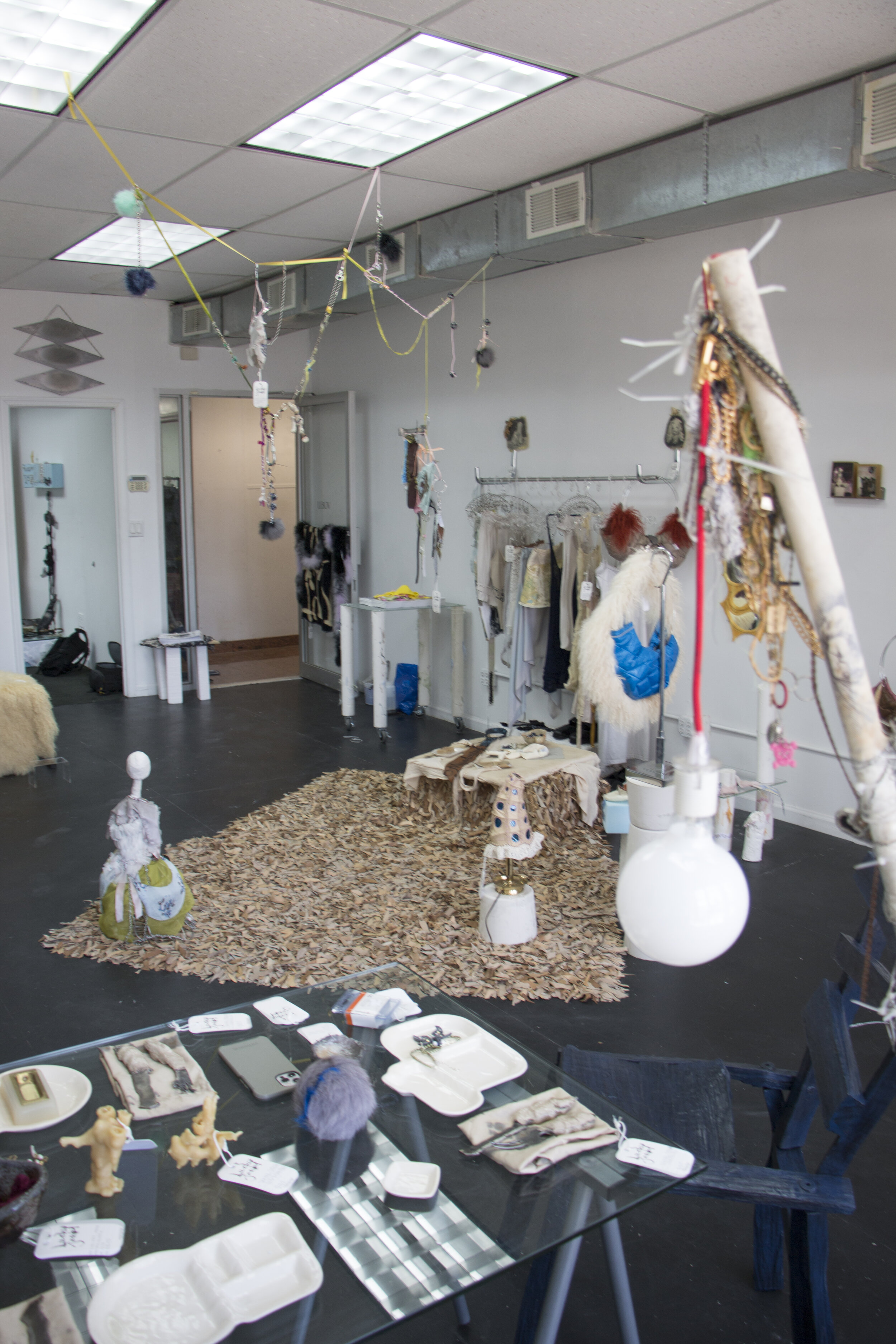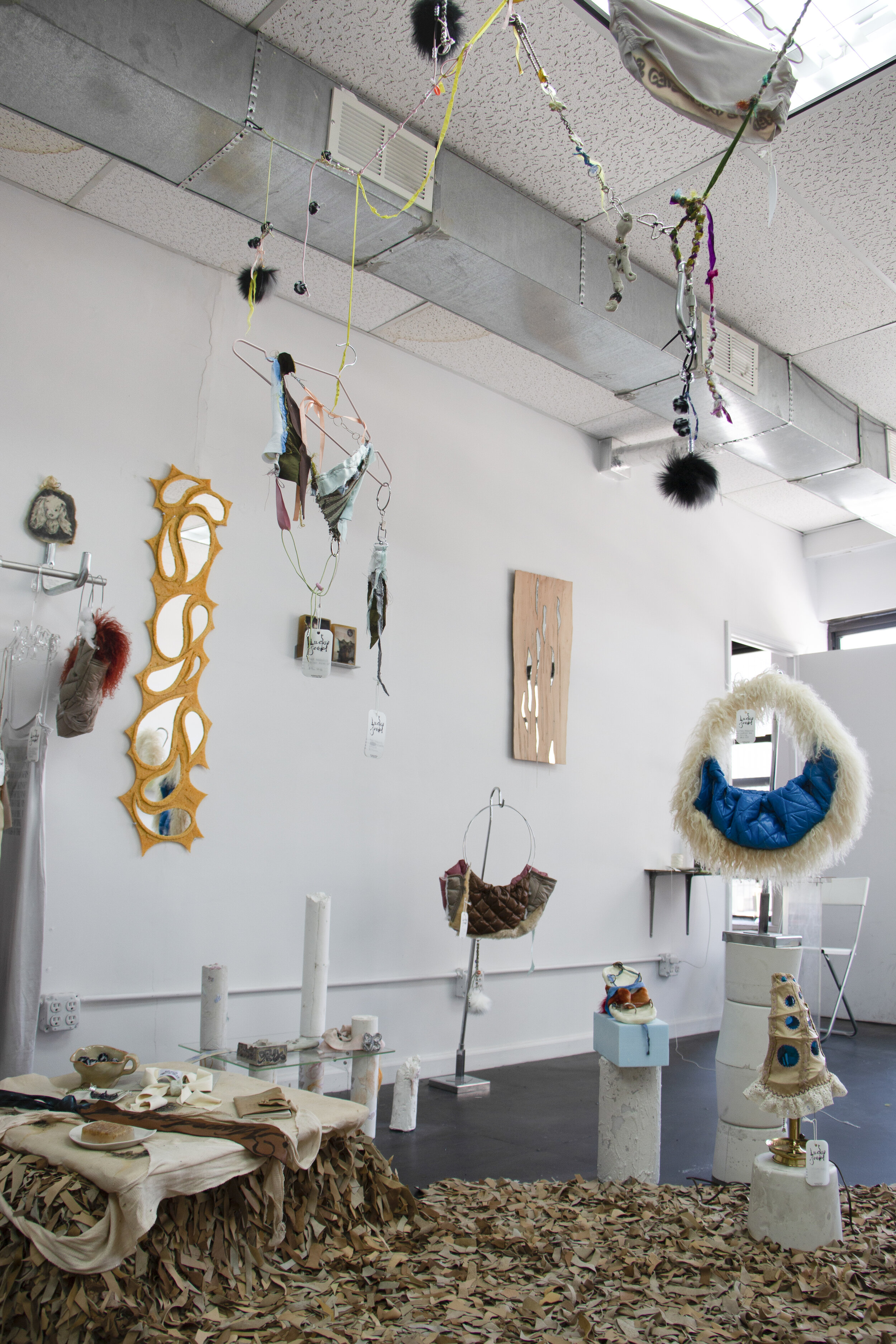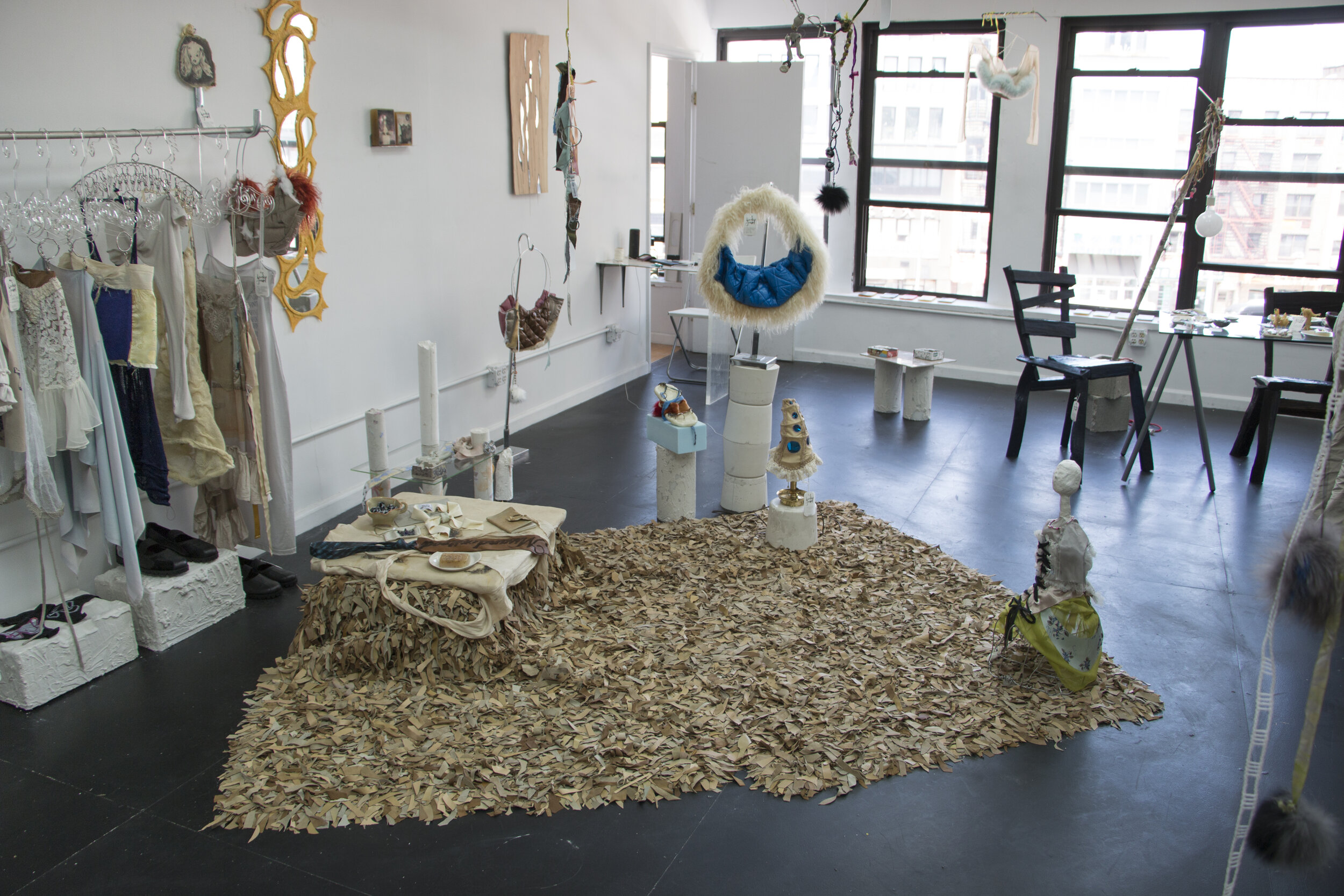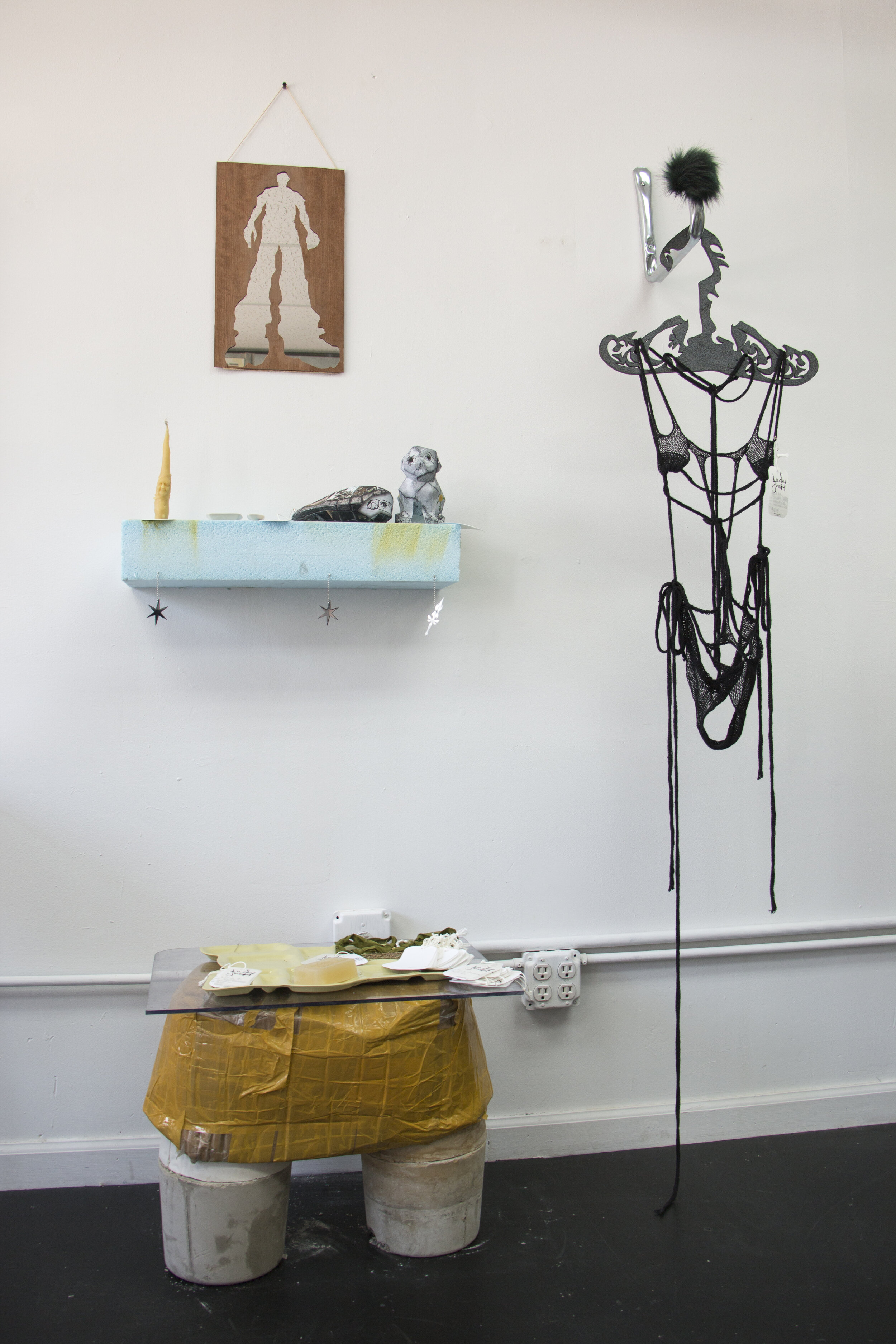Published September 2021 on Coeval | https://www.coeval-magazine.com/coeval/lucky-jewel
We look in the mirror and see a version of ourselves that no one else does, yesterday's insecurity hides under an oversize tee shirt, the recurring bad dream knots itself into a trestle tucked behind your left ear where a cubic zirconia earring dances like a curtain in the wind, pent up frustration behind puffy eyes and a disposition that straddles “chill” while caging a scream are underlined, not crossed-out by onyx eye-liner. We communicate by dressing, adorning the interiority of our inner sanctums with ideals as if first impressions could build utopias.
Silhouettes whisper and light fires and to Lucky Jewel, shopping is a feeling. The Chicago-born and NYC- based collective of makers and creatives founded by Olive Woodward, Ramona Beadie, Holly Richwine, Vivian Xu and Lola Dement Meyers span an array of disciplines and mediums, their unifying thread is an emotional one with one end tied to a hopeful, devout sentimentality and the other to your sacred heart. Lucky Jewel has occurred thrice before at various venues synonymous with house parties that you never wanted to leave and a nightclub that was turned into heaven’s doorstep. In its purest form it is an immersive shopping experience, an installation of delicate synergies wrapped in affectation, curated by intentional sensation and palpable convictions.
The fourth iteration of Lucky Jewel took place this summer at Lubov Gallery, spearheaded by independent designers - Shay Galla, Olive Woodward, Mimi Bhak and Lola Dement Myers who turned the space into a vessel for fulfillment. Shay and Olive invited their community of creatives into their fantasy where “play” was the main prerogative and allowed for their fellow makers an opportunity to experiment with processes that would yield products outside of their normal wheelhouse. Lucky Jewel has carved out a space for intentionality and awareness to exist parallel to consumerism because to purchase something at Lucky Jewel is synonymous with connection, with trying to take the feeling home. Coeval speaks to Lucky Jewel about their latest shopping extravaganza, redefining luxury as decadence in which decay, inevitably occurs.
INTERVIEW:
Lindsey: Shopping is a feeling is the ethos under which Lucky Jewel operates and I’m hoping you can start by talking about how you guys met and introduce Lucky Jewel as an entity.
Shay: It’s really sweet, me and Olive actually met through Lucky Jewel.
Olive: Yeah, we did. Shay was a contributing designer in the second Lucky Jewel when it was still taking place in Chicago and stayed with me for the event.
Shay: I flew over to Chicago and hadn't met any of them before. I ended up spending the whole time in this one building where Lucky Jewel was happening and we became friends—a lot of these people ended up moving to New York since then and that was around 2019.
Olive: Yeah, the origin story comes from our friend Vivian, who runs this Instagram called @lucky_jewel_iwanttt and it’s an account for eBay finds. She started this clothing swap in Chicago that was based on the idea that everyone brought their eBay rejects and swapped them, but a lot of people also brought things that they had made. It was a nice exchange of people and things, so when we met to talk about doing another one it had already taken on a life of its own.
Lindsey: There aren't many places to shop in New York that don’t feel too commercial or played out and what you’re adding to the equation is a sense of community.
Olive: It's all about the home and the preciousness of handmade things. It means something to surround yourself with objects that create a different living environment—everything that you interact with, you feel close to.
Shay: This is the fourth time that Lucky Jewel is happening—it happened twice in Chicago and once in New York. When it happened in Chicago it was held at this place that Olive had lived called Laura. The living room was massive, there were a lot of gallery shows and techno performances so it felt really natural to do something in this space. They were very accommodating when it came to having people gather together and hosting an event like that in a home as opposed to a gallery or club changes it so much because it evokes a sense of comfort and familiarity. It’s a full sensory experience which really sets it apart. The drinks were mind-blowing—the ice cubes had flowers in them and there was so much detail and consideration that you knew that someone put love into it and went the extra mile with everything. We talk a lot about the sentimental power of objects and things that stay with you forever.
Lindsey: There’s also this existing duality between the idea of home and permanence. It's interesting because nowadays everyone is talking about sustainability, but I think what’s missing from that conversation is sentimentality and knowing how to make things that mean a lot to people. Everything currently feels ephemeral because it all moves so quickly, and as a result, homogenization in aesthetics and brand identity are common. How are you establishing meaning, and in turn, helping others to establish meaning as well?
Shay: For us, I feel like so much of it is about the experience that we're creating and I think it's fully safe to say that Lucky Jewel changed my life. It really blew me away how much thought went into it and I just wanted to hang on, to grab something to keep. I’ve been off Instagram more in the past year because I’m sick of seeing the same thing over and over and being a maker—it gets into my head.
Olive: Every time we do another Lucky Jewel the community grows and there are so many people we’ve met through simply reaching out to them. This time around we had pieces from someone who lives in Copenhagen. The nice thing about being a shop is that it brings in another set of people to expand the community through the people who come and buy things—they’re a part of it, too.
Shay: We try to create this awesome experience and the stuff for sale represents taking a piece of that experience home. I feel like these hangers are literally the most important thing to me as a representation of Lucky Jewel because hardly anyone makes their own hangers. These are laser cut and the leftover pieces were taken and turned into hang tags. They were designed by Ramona Beattie, one of the LJ founders.
Olive: It’s an expansion of what’s possible with the items you make and from there you have to ask what those items are hung on. It’s expanding this vision of a whole world. It’s world building and there’s definitely a fantasy element to it—it’s a fantasy you can live with.
Lindsey: You’re essentially world building by community building, which is different than just curation because it requires an emotional response. What makes you resonate with someone’s work and how do you know if they’ll fit into the Lucky Jewel fantasy or utopia?
Olive: By seeing something, you can kind of feel and tell what went into it making it. One of the floating titles for the event was “don’t think about it” and it’s more so a feeling you get from looking at something. It’s mainly a sensory/emotional experience and I think there’s something here for everyone. I even sent my dad a picture of a chair that one of the artists made for this iteration [made by Yuki Gray] and he was like “I must have that chair.” It’s amazing to see the responses to objects.
Shay: As makers you can gauge pretty easily when something has really been thought about and when a lot of time and effort was put in. I love seeing witty solutions to things that I never would have thought about and how maybe someone was able to put things together in such clever ways that then seem obvious. I feel like it's very bedside table energy because it’s a place where so much stuff can accumulate. The other day, my mom sent me a photo of hers and I was like, “What is this?” and she was like, “It’s a story.” I feel like Lucky Jewel does fit this notion of a sentimental collection of items in some way or another and it’s that on a huge scale.
Lindsey: When we think of sentimental objects we think of heirlooms. It’s as if the objects retain all of the emotional value imbued into them, and quite often, they’re passed on and not bought. How are you working to create new heirlooms and what have you acquired that you consider to be an heirloom?
Shay: This necklace that Nora Izu made for me is definitely an heirloom—I will pass this on to my kids. My mom had this snake ring that had ruby eyes in it and she said that’ll be mine one day. My dad is an arts and antiques collector so he definitely passed that down to me. He used to have a store on Lafayette and go to these flea markets on the weekends. He always brought me back weird things like handmade dolls and things that were falling apart that you’d want to preserve.
Olive: Last year my parents sent me this basket ottoman thing that my great grandmother made by hand, which still has her sewing kit in the storage compartment. It felt really special because I had never met her, but could build a relationship with her through this object that she had made. That’s very Lucky Jewel-- to make things for yourself and then to pass them onto your guests.
Lindsey: The experience itself is something that you’re passing on. What kind of experience do you want people to have and what do you want it to inspire?
Shay: I hope it inspires more world building. I hope people feel like this is a world they can step into, relate to, and take something away from. I also want people to laugh and to maybe see that things don’t have to be so serious. I want people to feel welcome.
Olive: Last week we did a photo shoot and I was the step-in fit model. I put an outfit on and I was like “Wow, oh my god.” I felt really cool and it’s about being able to imagine a version of yourself that maybe you didn’t think about before. There’s a lot of freedom and it feels like a space to try things out and play. Even some of the people in it made things specifically for Lucky Jewel. If they usually paint, maybe they used this as an opportunity to experiment with making something else. People have an opportunity to expand their practice and that’s special.
Lindsey: That's important because if you’re known for doing something, it’s hard to feel like you can evolve creatively and expand your practice.
Olive: I usually make clothes and accessories and my favorite thing about Lucky Jewel is being able to make furniture-esque objects and working on a larger scale. I like when opposite and unexpected elements are combined, such as these pedestals that Mimi made are covered in cement but they’re actually really light—there’s something funny about that.
Shay: Yeah, we’ve definitely been looking on the streets for inspiration and it’s about seeing value in things that others might discard. We ask ourselves, “What could this become?”
Lindsey: That ties into the ideas of power, value, and transformation. Power usually takes on this connotation of brute strength alone, but to what extent is a sense of freedom also involved?
Olive: Anything that gives you an emotional reaction has power.
Shay: For example, there was this random tarp on the street and the box underneath it hit a note so we were like “Okay, let's bring it upstairs” and now it's gonna receive all this love and maybe have a ribbon on it or something. It becomes special.
Lindsey: I think that openness unlocks a lot of room for the actualization of potential. It's also getting others to see how special these pieces are, and in order to do so, you have to let them go sometimes. Is that part hard?
Shay: Oh my god, yes.
Olive: Yeah, but once you see people shopping and interacting with that thing and know that it’s going to mean a lot to someone else, that’s the most important part because it’s going to a good home. Everything really does mean so much to me, and in my home, all the things there have been the result of personal interactions. It feels very sacred.
Lindsey: If that's the case, what does the decision making process in choosing to sell certain things online entail? Is there any value to that experience if so much of it is derived in person?
Olive: The online shop is to expand Lucky Jewel for people that aren’t here and to have a presence when we’re not doing a space—a lot of people that made things for us don't live in New York. Something is probably lost by not doing it in New York, but…
Shay: The sharing of things is really the most important. I personally never shop online because I need to touch things, try them on, and I’m just impatient and don’t want to wait. I wish I did shop more online because eBay is awesome, but I see it more so as a way of being able to spread things.
Olive: One time I was in this bidding war on eBay and found out later when I was wearing the jacket I won that I was bidding against my friend Kacie, who actually made a lot of pieces for us before. When we realized we were up against each other it made me aware of all of the interactions we have online that we don’t even know about. It would be so cool if we could make Lucky Jewel’s website more interactive somehow. It kind of goes back to the clothing swap at Lucky Jewel one where you really had to dig to find the perfect thing.
Shay: Lucky Jewel is just so much digging—it’s looking for things in unexpected places. Maybe that has to do with the vulnerability of it all, this idea of searching and hoping. It's optimism and giving something a chance to be sentimental.
Lindsey: It's emotional curation for lack of a better word and it’s not necessarily for everyone because it happens in this act of stumbling upon something and feeling a sense of fate. Since this is the fourth Lucky Jewel does it feel different?
Olive: It kind of died off for a while and there were a few other people that were doing it at one point but aren’t any more. We were just talking about how it should happen again and in that time period, I didn’t realize how much I missed it. We’ve been spending every day together and just went on to develop this synergy where there will be an idea and it all develops from there. This one definitely feels bigger and more “professional” for lack of a better word. We’ve learned a lot each time
Shay: This one feels more fully realized and there are more people involved. There's definitely an innate difference when it's happening in your home versus happening at a nightclub—which is where the last one was—or a gallery. Those are all dramatically different settings for sure.
Lindsey: But you’re still bringing the feeling of home into each of those environments and it’s knowing and learning how to translate that emotion physically. What’s the difference between an event being fulfilling versus it being successful? Obviously you’re selling these, but are there more emotional measures that serve as the actual goals? It’s not like you could call Lucky Jewel a pop-up.
Olive: We have a weird feeling about the word “pop-up.” It’s like why can’t it just be ephemeral? “Pop-up” just feels like a damper. Fulfillment comes from seeing the world built. The Lucky Jewel at the nightclub 444 was much less fulfilling because it was more of an experiment than anything. Having a space that we can truly occupy and set up as an interactive experience is the most fulfilling because there’s a chance for things to be unexpected and discovered—a chance to see how things feel right together.
Shay: I feel like the success of it has never been that relevant. The past ones were in an apartment and a nightclub we’d go to every weekend where our friends work. In this context, maybe the definition of success is a little different when it's on a bigger scale. I feel like in a way, this one is also an experiment and you’re so right, Olive—the fulfillment is in seeing how everything interacts and if it can stand on its own legs.
Lindsey: The idea of interaction is interesting because you’re receiving pieces from people around the world who you might’ve never met and they’re sharing space with people they might not know. How did you put it all together and how did you know it was done or ready?
Olive: It goes back to this idea of playing and seeing what happens when you put two things together. It’s creating room for the unexpected by not being too set on something immediately.
Lindsey: The idea of play is a funny way to think about luxury.
Olive: I think luxury is a theme in an unexpected way. It’s just what feels decadent, but knowing it’s not necessarily this common idea of luxury.
Shay: The more sentimental something is, the more luxurious it is to me. The amount of time someone puts into something is decadence. To know as the maker that something is 1000% is decadent.
Olive: I like the word decadence because at its root it means “to decay.” There’s this idea of something reaching its pinnacle on the cusp of a fall.
Lindsey: Thinking about decay, to what extent is stability the product of risk in your own lives?
Olive: I think that’s true. Even in doing this, the first time was a risk and experiment and those things kind of go together. I feel like this has been a very stabilizing thing in my life, and when it’s occurring, I feel very in my element.
Shay: I feel like this is it to me. I’d risk whatever it takes to make it stable because it’s so close to my heart, makes me feel close to so many people, and makes other people feel good. I think it’s telling that this event took on a life of its own and has this magnetism to it. It has the power to bring people together. Putting it all together and learning how to do something is a risk—but at its core—it's so stable, pure, and good.






